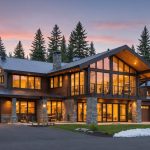Understanding Heat-Efficiency in Cold Climates
In habitats with harsh winters, heat-efficiency becomes crucial for maintaining comfort and reducing energy costs. Typically, homes can experience significant heat loss through poorly insulated walls, roofs, and windows. This leakage not only inflates energy bills but also reduces the home’s overall efficiency. Understanding where and how heat escapes is the first step in rectifying the issue.
Incorporating sustainable design principles is vital in cold climates. Homes built with such considerations often feature better insulation, double-glazed windows, and energy-efficient heating systems, all contributing to effective energy conservation. These designs minimize heat loss by creating barriers against cold and maximizing heat retention.
In the same genre : Revamp your home office: stylish and clutter-free ways to personalize your workspace
Prioritizing heat-efficiency during home construction brings considerable benefits. For instance, it leads to a significant reduction in heating costs, enhancing affordability and accessibility of living spaces. Moreover, an energy-efficient home is an environmentally friendly option, as it reduces reliance on non-renewable resources. Not only are you saving on utility expenses, but you are also contributing to a reduction in your carbon footprint.
Therefore, focusing on energy conservation through smart building practices is an investment that pays off both financially and ecologically in regions prone to cold temperatures.
In the same genre : Revamp your guest room: create a multifunctional oasis with an at-home fitness area!
Insulation Techniques for Optimal Heat Retention
Choosing the right insulation strategies is crucial for enhancing your home’s thermal performance and achieving significant energy savings. Exploring various types of insulation materials can help you determine which option best suits your needs. Materials like fiberglass, cellulose, and foam offer different levels of effectiveness. Fiberglass is popular for its affordability and versatility, while cellulose is eco-friendly and effective. Spray foam, known for its superior thermal performance, creates an airtight seal, reducing heat loss effectively.
For maximizing insulation, focus on walls, roofs, and floors. Walls benefit from batt or blown-in insulation methods, which fill gaps and prevent air leakage. In roofs, attic insulation, such as spray foam or blown-in cellulose, acts as a formidable barrier against rising heat. Floor insulation, particularly in basements and crawl spaces, combats heat loss from below.
Integrating vapor barriers and air sealing techniques is vital. Vapor barriers prevent moisture accumulation, which can compromise insulation performance. Combining these with air sealing techniques ensures a comprehensive approach, preventing drafts and enhancing energy savings. Properly sealed homes retain conditioned air longer, reducing reliance on heating systems and leading to cost savings.
Selecting the Right Windows for Energy Efficiency
When it comes to energy-efficient windows, understanding the differences among single-pane, double-pane, and triple-pane designs is crucial. Single-pane windows, with their solitary layer of glass, offer minimal insulation. In contrast, double-pane windows utilize two layers of glass with a pocket of air or gas in between, significantly boosting their thermal performance. Triple-pane windows take it further with an additional layer, providing even greater energy efficiency.
Low-E (low-emissivity) coatings are another vital factor in window performance. These thin metallic layers reflect heat while allowing light to pass through, maintaining indoor temperatures. Similarly, filling the space in double- or triple-pane windows with argon gas enhances insulation, as it transfers less heat than air.
Proper installation also plays a pivotal role in maximizing window efficiency. Poorly installed windows, regardless of their glazing options, can lead to drafts and temperature fluctuations. Ensuring that frames are airtight and sealed mitigates energy loss and improves overall thermal performance.
Selecting the right windows involves both technology and technique. By combining the best materials with expert installation, homeowners can optimize their window’s energy efficiency, leading to cost savings and increased comfort.
Efficient Heating Systems and Their Applications
Heating systems play a crucial role in maintaining comfortable living environments. They range from conventional systems like forced-air furnaces to alternative heating solutions such as radiant or geothermal systems. Understanding the efficiency and application of these systems can significantly affect energy consumption and cost.
Conventional systems like baseboard heating and gas furnaces are widely used but can be less energy-efficient. Geothermal heat pumps, on the other hand, utilize consistent underground temperatures to deliver heating, offering an eco-friendly and energy-efficient heating solution.
Incorporating smart thermostats and zoning into your heating system can enhance efficiency. Heating system zoning allows for more control over different areas of a property, ensuring that energy is directed where it is most needed and minimizing waste.
When comparing cost versus benefits, consider the initial investment against long-term savings. While alternative heating solutions might have higher upfront costs, their efficiency can lead to considerable savings over time. Smart thermostats, while relatively inexpensive, provide quick returns in energy savings.
- Pros of Energy-Efficient Heating:
- Long-term cost savings
- Reduced environmental impact
- Enhanced comfort and temperature control
Ultimately, the choice depends on your specific needs, budget, and environmental considerations.
Incorporating Passive Solar Design Elements
Incorporating passive solar design into your home involves strategically using natural resources for heating and cooling. At the core of this approach is maximizing solar gain, a pivotal aspect that ensures the sun’s energy is utilized efficiently.
Key principles of passive solar heating include optimal building orientation, effective window placement, and usage of materials with high thermal mass. The orientation of your home plays a critical role, as it should ideally face true south to capture maximum solar gain during winter while minimizing excess heat in the summer. This setup allows for maximum natural heating, reducing reliance on mechanical systems.
Window placement is equally essential. Large, south-facing windows allow for significant solar gain, while well-insulated windows on the north side minimize heat loss. Incorporating features like thermal mass materials (e.g., concrete, bricks) inside the home can store solar energy during the day and release it at night, aiding in natural heating.
Interestingly, case studies of passive solar homes in cold climates demonstrate the effectiveness of these strategies. Such homes maintain comfortable indoor temperatures with minimal energy input, illustrating the practical benefits of well-executed passive solar design. By carefully considering these elements, homeowners can create energy-efficient living spaces that capitalize on available sunlight.
Choosing the Right Materials for Durability and Efficiency
Selecting appropriate material choices, particularly thermal mass materials, is crucial for building energy-efficient and durable structures. These materials, like concrete or stone, excel in retaining heat due to their dense properties, making them ideal for managing temperature in fluctuating climates. Such materials absorb and store thermal energy during the day and gradually release it as temperatures drop, reducing dependency on artificial heating.
When considering construction materials for cold climates, the pros and cons are essential. Thermal mass materials offer benefits like improved energy efficiency and lower heating costs, but they can be costly and require skilled labor for installation. Insulating materials like wood and fibreboard are more affordable and easier to install, but they might not be as effective in heat retention.
Sustainable building practices often incorporate thermal mass materials to ensure long-term environmental benefits. Using eco-friendly construction materials reduces the carbon footprint and can lead to significant energy savings over time. Embracing these practices not only supports durability and efficiency but also aligns with global sustainability efforts. Consider these aspects to make informed material choices for your construction needs.
Cost Estimates and Financial Considerations
Delving into the initial costs versus the long-term savings of energy-efficient designs reveals a compelling narrative for homeowners. Although the upfront investment in features like high-performance insulation or energy-efficient windows may seem significant, the savings on energy bills over time often justify the expenditure. These savings contribute not only to lower monthly utility bills but also potentially add to the home’s overall value.
Moreover, numerous financial incentives and rebates are available to make these energy efficiency investments more affordable. Programmes vary by region but frequently include tax credits or rebates for installing energy-efficient appliances or insulation. Checking with local energy providers or government agencies can uncover these opportunities, helping homeowners offset initial costs.
Successfully budgeting for home efficiency renovations necessitates a strategic approach. Allocating funds to the areas with the greatest cost savings potential is key. Creating a detailed budget plan that considers personal finances and evaluates the return on investment can guide homeowners in their renovation journey. Consulting with professionals or using online calculators can also provide insightful projections for long-term benefits, ensuring that investments are both cost-effective and energy-efficient.
Checklist for Implementing Heat-Efficient Strategies
Implementing heat-efficient strategies involves making well-informed decisions about design strategies and efficiency improvements. Begin with a step-by-step guide to assess your home’s existing efficiency. Evaluate insulation quality, seal leaks, and check windows for drafts. Prioritizing these areas is crucial for significant improvements.
When planning new builds, focus on a checklist of heat-efficient features. Some key aspects include:
- High-quality insulation materials
- Energy-efficient HVAC systems
- Double or triple-glazed windows
- Passive solar design strategies
Selecting these features enhances the thermal performance of your space, reducing energy consumption and utility costs.
Post-implementation, it’s essential to monitor and adjust performance. Use smart thermostats and energy monitoring systems to track thermal efficiency. This technology allows you to identify any areas requiring further adjustments, ensuring sustained improvement.
Regular maintenance is also vital. Inspect HVAC systems, replace inefficient components, and update insulation materials as needed. These steps provide crucial insights and adjustments that optimize the comfort and sustainability of your home.
By crafting a thorough implementation checklist and focusing on key efficiency improvements, you can effectively enhance the heat efficiency of your home, contributing to both environmental sustainability and cost savings.
Visuals and Case Studies to Support Design Decisions
Incorporating visuals such as diagrams and blueprints into design planning is crucial for enhancing understanding and clarity among stakeholders. Visuals translate complex ideas into more digestible formats, fostering better communication and collaboration. They can dramatically improve the accuracy of conveying design intentions and can serve as a reference to ensure consistency during the execution phase.
Case studies offer valuable insights into real-life applications, showcasing scenarios where design choices have effectively addressed specific challenges. These documented examples provide evidence of what has been tried and tested, helping to inform future projects. For instance, examining design examples of heat-efficient homes can reveal strategies such as optimal material use and innovative architectural solutions that enhance energy conservation.
By analyzing these case studies, designers can draw inspiration for developing their solutions. Observing successful implementations helps in identifying potential pitfalls and best practices, ultimately guiding informed decision-making. This approach not only inspires creativity but also reinforces the feasibility and effectiveness of proposed designs. Leveraging both visuals and case studies in planning stages can significantly enhance the quality and success of design projects, making them indispensable tools in the designer’s toolkit.
Understanding Heat Efficiency in Cold Climates
In cold climates, maintaining optimal heat efficiency is paramount. Homeowners often struggle with retaining warmth, facing unique challenges such as high heat loss through poorly insulated walls or windows. This loss can lead to increased energy consumption as heating systems work harder to maintain comfortable indoor temperatures.
Thermal performance plays a crucial role in this context. It refers to how well a building can maintain internal temperatures, and it significantly impacts energy efficiency. High thermal performance means less energy is needed to heat a space, lowering energy bills and reducing environmental impact.
Designing for energy efficiency in cold climates brings several benefits. It not only reduces heating costs but also enhances indoor comfort by eliminating drafts and cold spots. Additionally, energy-efficient homes contribute positively to the environment by reducing carbon footprints, aligning with growing environmental consciousness and regulations.
In conclusion, paying attention to architectural design and materials can improve a home’s heat efficiency. Choices such as insulated walls, energy-efficient windows, and doors, along with advanced heating systems, collectively improve a home’s thermal performance, offering both economic and environmental advantages. This understanding is vital for homeowners looking to optimize their living conditions while being mindful of costs and ecological impacts.
Insulation Techniques for Maximum Heat Retention
An essential part of maintaining a consistent indoor temperature and achieving energy savings is using effective insulation techniques. Insulation serves as a thermal barrier, reducing heat loss and subsequently lowering energy costs. Choosing the right materials can enhance these benefits.
Evaluating Different Insulation Materials
When considering various insulation materials, the most common options are fiberglass, spray foam, and cellulose. Fiberglass insulation is well-known for its cost-effectiveness and ease of installation, making it a popular choice. Spray foam, though more expensive, provides an excellent air seal and superior thermal resistance, which is especially beneficial in hard-to-reach areas. Cellulose insulation, made from recycled paper, is an eco-friendly option that offers good coverage and thermal performance.
Recommended R-values for Cold Climates
For insulation to be effective, particularly in cold climates, the R-value—a measure of thermal resistance—should be carefully considered. For instance, a higher R-value is necessary for colder regions to ensure maximum heat retention. Walls and roofs typically require a higher R-value compared to basements, where the ground naturally provides some insulation.
Best Practices for Insulating
For optimal results, follow best practices in insulating walls, roofs, and basements. Ensure that insulation materials are installed without gaps to avoid heat escape. Properly sealing joints and edges further enhances the insulation’s effectiveness, creating a comprehensive thermal barrier.
Implementing Passive Solar Design
Passive solar design capitalises on natural heating by focusing on the building’s orientation and structural features. Its foremost strategy involves aligning the building orientation to harness maximum solar gain. Ideally, buildings in the northern hemisphere should face true south, while those in the southern hemisphere should face true north. This orientation maximises sun exposure during winter months when additional heating is needed.
Window placement is crucial for effective passive solar design. Large, well-insulated windows should be installed on the southern-facing side to allow sunlight to penetrate deep into the living spaces. Meanwhile, eaves or overhangs can be incorporated to shade these windows in summer, preventing overheating.
An integral component of passive solar design is the use of thermal mass. Materials such as concrete, brick, or stone absorb, store, and slowly release heat, maintaining a stable indoor temperature. Placing these materials in direct sunlight ensures optimal heat retention, reducing the reliance on artificial heating systems.
By aligning building orientation, window placement, and thermal mass utilisation, passive solar design enhances natural heating, offering a sustainable and efficient means to maintain comfortable temperatures year-round.
Choosing Energy-Efficient Windows and Doors
Energy-efficient windows and doors can significantly impact your home’s overall energy savings. When considering your options, explore various glazing types like double or triple glazing and Low-E coatings. These technologies are designed to reduce heat transfer, ensuring that your home remains comfortable while cutting down on energy consumption.
To illustrate, double glazing incorporates two layers of glass with a space between them, often filled with inert gas. This setup provides better insulation than single-pane windows. Meanwhile, Low-E coatings are applied to glass surfaces to minimize the amount of infrared and ultraviolet light that enters your home without compromising natural light.
Proper installation plays a crucial role in maximizing the benefits of these advanced windows and doors. Without meticulous fitting and sealing, air leaks could negate the energy savings.
It’s essential to weigh the cost-benefit analysis of upgrading to energy-efficient options. Initially more expensive, these upgrades can lead to long-term savings on heating and cooling expenses. Lower energy bills and increased comfort over time often outweigh the upfront costs. Consider these aspects carefully to make an informed decision tailored to your needs.
Renewable Materials and Sustainable Practices
Utilising renewable materials in construction offers numerous benefits. These materials, derived from resources that naturally regenerate, help reduce the carbon footprint of buildings. They often provide improved insulation, aiding in heat efficiency and reducing energy consumption. For homeowners, this results in lower energy bills and a greener environmental impact.
One critical aspect of sustainable building is incorporating practices that enhance heat efficiency. These practices include using materials such as bamboo and reclaimed wood, which have excellent insulating properties. Key features of sustainable homes also involve proper orientation to maximise solar gain, triple-glazed windows, and efficient heating systems.
Across different eco-friendly home designs, several case studies highlight the success of these practices, especially in colder climates. In Iceland, for instance, homes utilise turf roofs, which are not only oxygen-providing but also provide exceptional insulation against harsh weather conditions. In Canada, homes integrate geothermal heating solutions combined with solar panels, significantly minimising reliance on conventional energy sources.
Overall, adopting renewable materials and sustainable building practices leads to enhanced living environments that are both comfortable and environmentally responsible. Homeowners can take confidence in making informed decisions that contribute to long-term sustainability.
Smart Technology Integration for Energy Management
In today’s evolving digital landscape, smart technology plays a pivotal role in enhancing energy management within homes. Devices like smart thermostats and energy monitors are essential in optimizing heating. By accurately sensing and adjusting to the home’s current temperature, smart thermostats minimize energy wastage by ensuring heating systems operate efficiently. This not only saves energy but also reduces utility bills.
Home automation systems offer a seamless integration of various smart devices, elevating the potential for energy efficiency. For instance, when linked with energy monitors, they can automatically adjust the settings of appliances based on real-time energy consumption data. This ability to proactively manage energy distribution ensures a balanced and efficient use of resources.
Looking into future trends, smart home technologies are expected to incorporate advanced machine learning algorithms that predict energy needs based on user habits and external factors like weather. This predictive analysis will further enhance cold climate efficiency by pre-emptively adjusting heating systems before temperature drops.
These innovations make home automation not only a luxury but a necessary component of modern living, ensuring comfort and sustainability simultaneously. Adopting these technologies allows homeowners to enjoy a smarter, more energy-efficient home environment.
Cost Considerations and Energy Savings
When embarking on a home investment in heating efficiency, understanding the cost analysis is key. Initial costs can vary depending on the chosen improvements, such as insulation upgrades or the installation of energy-efficient heating systems. However, the potential to save on heating bills over time often offsets these expenses.
Implementing energy savings strategies can dramatically reduce monthly utility costs, making the upfront investment worthwhile. For example, enhanced insulation not only maintains a comfortable indoor temperature but significantly cuts down on heating bills. Over several years, these savings accumulate, effectively paying back the initial outlay and even potentially increasing the property’s value.
Additionally, various financial incentives and rebates are available to support energy-efficient home upgrades. These incentives can substantially lower the financial burden of implementing heat-efficient strategies. Rebates might cover a percentage of the installation cost or offer tax credits, easing the immediate financial impact.
When analyzing cost considerations, it’s crucial to weigh both immediate expenses and long-term savings. This approach ensures that homeowners make informed decisions that not only improve comfort but also enhance financial efficiency. Engaging with local utility providers or exploring government programs can further optimize energy savings and maximize financial benefits.
Common Challenges and Solutions in Cold Climate Design
Building in cold climates presents unique challenges, requiring thoughtful planning and implementation of effective design solutions. A prevalent issue in such environments is the presence of moisture and condensation. This not only compromises the integrity of the structure but can also lead to health concerns for inhabitants. Addressing this involves a multifaceted approach, such as using vapor barriers and ensuring proper ventilation to mitigate moisture build-up.
When discussing energy efficiency, some common pitfalls include poor insulation and inadequate sealing techniques. These can result in excessive heat loss, raising both environmental and financial costs. Employing energy-efficient design solutions can prevent such issues. This might involve using high-quality insulation materials, airtight windows, and doors, as well as integrating advanced HVAC systems.
Expert advice becomes vital when experiencing troubleshooting challenges post-construction. Professionals often recommend regular maintenance checks and employing diagnostic tools to identify energy loss spots and moisture accumulation areas.
In summary, designing for cold climates demands a proactive strategy to manage moisture, optimize energy efficiency, and routinely troubleshoot emerging issues to maintain structural longevity and inhabitant comfort.













